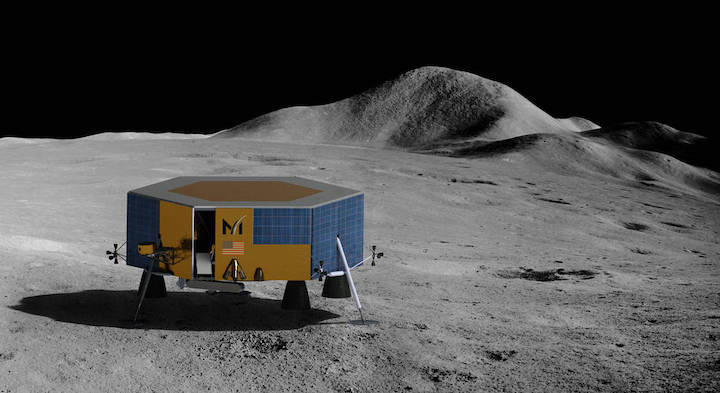15.04.2020

Credit: Masten Space Systems
NASA has awarded Masten Space Systems, a small company based in Mojave, California, a $75.9 million contract to deliver nine science and technology instruments to the moon’s south pole in 2022 with its XL-1 robotic lunar lander.
Masten is the fourth company to receive a lunar landing mission task order through NASA’s Commercial Lunar Payload Services, or CLPS, program. NASA terminated a task order with one of the four companies, Orbit Beyond, last year after it encountered “internal corporate challenges.”
Astrobotic and Intuitive Machines, NASA’s other two CLPS contract winners, are scheduled to launch their first robotic landers to the moon in 2021.
Masten’s first XL-1 landing mission is scheduled to reach the moon by December 2022, the company said in a statement.
NASA announced Masten as the winner of a competition for the next CLPS task order April 8. The CLPS program aims to purchase rides to the moon for NASA-sponsored science and technology demonstration payloads aboard privately-developed robotic landers.
If successful, Masten’s XL-1 lander is expected to be the first mission to softly land at one of the moon’s poles. All previous successful soft landings on the moon have touched down at locations closer to the equator, and Astrobotic and Intuitive Machines are targeting mid-latitude landing sites.
NASA says it used virtual presence and communications to continue work on the CLPS procurement amid the coronavirus pandemic, and the agency awarded the task order to Masten on schedule.
“Masten is thrilled to have NASA as our anchor customer on this mission,” said Sean Mahoney, CEO of Masten Space Systems, in a statement. “As we, like the rest of the world, work to keep our employees and families safe in these trying times, we’re glad to see America’s return to the moon and space commerce moving forward.”
Under the terms of the contract, Masten will manage the XL-1 lunar lander mission. Masten will provide the spacecraft, arrange launch services, and operate the lander throughout the mission.
“Under our Artemis program, we are going to the moon with all of America,” said NASA Administrator Jim Bridenstine. “Commercial industry is critical to making our vision for lunar exploration a reality. The science and technology we are sending to the lunar surface ahead of our crewed missions will help us understand the lunar environment better than we ever have before.”
The CLPS missions are precursors to NASA’s Artemis landings, the first of which is scheduled to carry astronauts to the lunar surface by the end of 2024.
“These CLPS deliveries are on the cutting edge of our work to do great science and support human exploration of the moon,” Bridenstine said in a statement. “I’m happy to welcome another of our innovative companies to the group that is ready to start taking our payloads to the Moon as soon as possible.”
Masten competed against a roster of other providers eligible to bid for CLPS lunar landing missions. The 14 companies selected by NASA as CLPS providers include SpaceX, Blue Origin, Lockheed Martin, Sierra Nevada, Ceres Robotics, Tyvak Nano-Satellite Systems, Deep Space Systems, Draper, Firefly Aerospace and Moon Express, plus the four companies that have now won CLPS task orders.
Founded in 2004, Masten Space Systems has developed and planetary lander prototypes in Mojave, where the company has performed more than 600 vertical takeoff and vertical landing tests. The XL-1 lander scheduled for launch in 2022 will be Masten’s first space mission.
Derived from Masten’s earlier prototypes, the XL-1 lander can deliver hundreds of kilograms of payloads to the lunar surface, the company said in a statement. NASA has reserved around 176 pounds (80 kilograms) of payload capacity on the first XL-1 lander, and Masten is offering the rest of the lander’s payload envelope to commercial customers.
“Masten’s XL-1 lunar lander is built on over a decade of experience in vertical takeoff and vertical landing technology (VTVL) with a focus on reusability,” said David Masten, the company’s founder and chief technology officer. “We’re grateful for all the partners and customers who have worked with our team to perform hundreds of successful rocket landings. This experience has helped us develop the enabling technology of entry descent and landing that will ensure precise and safe landings on other celestial bodies.”
The nine NASA instruments to be flown on the first XL-1 lander include small privately-developed rover named MoonRanger that carries its own sensor, a neutron spectrometer designed to detect hydrogen in lunar soil. The XL-1 lander itself will carry a camera suite, a robotic arm with a scoop, a radiometer, sensors to measure lunar surface composition, an instrument to measure the lunar radiation environment, and a passive laser retroreflector array that could support navigation of future lunar missions.
Masten has not announced the launch vehicle for the XL-1 lander mission in 2022.
NASA plans to award its next CLPS task order by the end of May for another robotic mission to the moon’s south pole in 2023 with the space agency’s VIPER rover to search for water ice deposits.
Quelle:SN
